Fruit comes in all shapes and sizes, and almost all fruits are primarily a source of carbohydrate.
However, there is a big difference between blackberries and watermelon regarding their respective fiber content.
For those looking for some fiber-rich options, this article provides a list of fruits high in fiber.
1) Apple
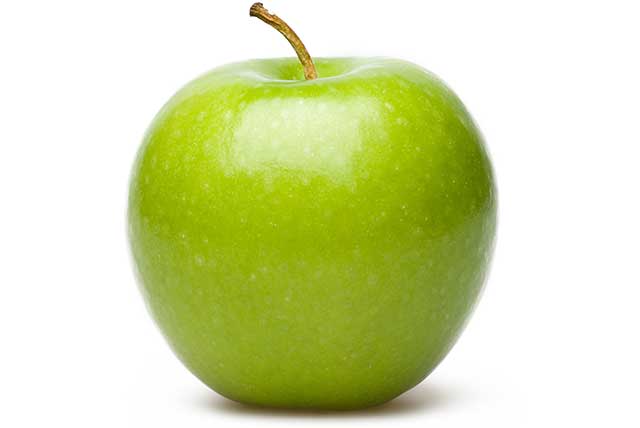
Apples are a moderate source of fiber, and one medium-sized apple provides 4.4 grams (1).
Despite this, apples are not very fiber-dense compared to their total carbohydrate and calorie content.
| Fiber: | 4.4 g |
| Total Carbohydrate: | 25.1 g |
| Calories: | 95 kcal |
| Fiber: | 2.4 g |
| Total Carbohydrate: | 13.8 g |
| Calories: | 52 kcal |
It is also worth noting that there are many different apple cultivars, and each of them have some nutritional differences.
See this guide to the different types of apples for more information.
2) Avocado
Avocado is unique for fruit because it is predominantly a source of healthy fats.
Furthermore, the carbohydrate that avocados do provide is almost all fiber (2).
Avocados also contain a wealth of essential vitamins and minerals in significant quantities, so this fruit offers a lot nutritionally.
See this complete guide to avocado for more information.
| Fiber: | 9.2 g |
| Total Carbohydrate: | 11.75 g |
| Calories: | 227 kcal |
| Fiber: | 6.8 g |
| Total Carbohydrate: | 8.6 g |
| Calories: | 167 kcal |
3) Blackberries
Blackberries are one of the tastiest fruits, and they supply a good amount of fiber too.
For instance, more than 50% of their carbohydrate content is fiber (3).
Additionally, blackberries contain a rich source of vitamin C.
Combine them with some heavy cream for a healthy and delicious dessert.
See this full guide to blackberries for more information.
| Fiber: | 7.6 g |
| Total Carbohydrate: | 13.8 g |
| Calories: | 62 kcal |
| Fiber: | 5.3 g |
| Total Carbohydrate: | 9.6 g |
| Calories: | 43 kcal |
4) Blueberries
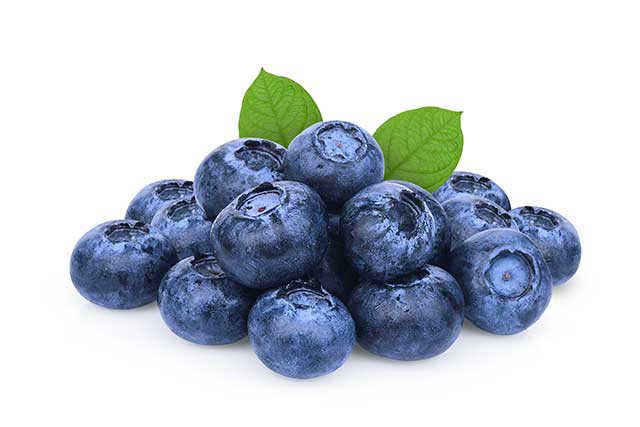
Blueberries have one of the healthiest reputations amongst all fruit, and they are perhaps most famous for their anthocyanin content, which is a type of polyphenol (4).
However, they don’t quite match up to blackberries for their fiber content.
A half-cup serving of blueberries supplies 1.8 grams of fiber (5).
| Fiber: | 3.6 g |
| Total Carbohydrate: | 21.5 g |
| Calories: | 84 kcal |
| Fiber: | 2.4 g |
| Total Carbohydrate: | 14.5 g |
| Calories: | 57 kcal |
5) Breadfruit
Breadfruit is an exotic fruit that grows in tropical regions.
Although the fruit is difficult to find in its fresh state, it is available around the world in a frozen form.
This fruit is relatively starchy, and some people claim the taste resembles bread, hence the name.
A small breadfruit contains 4.7 grams of fiber (6).
| Fiber: | 10.8 g |
| Total Carbohydrate: | 59.7 g |
| Calories: | 227 kcal |
| Fiber: | 4.9 g |
| Total Carbohydrate: | 27.1 g |
| Calories: | 103 kcal |
6) Cranberries
Cranberries are little red berries with a tart taste.
These berries are a good source of vitamin C, and they can be eaten by themselves or made into various teas, juices, and condiments.
Cranberries are reasonably high in fiber, and a cup serving provides 4 grams (7).
| Fiber: | 4 g |
| Total Carbohydrate: | 13.2 g |
| Calories: | 51 kcal |
| Fiber: | 3.6 g |
| Total Carbohydrate: | 12 g |
| Calories: | 46 kcal |
7) Durian
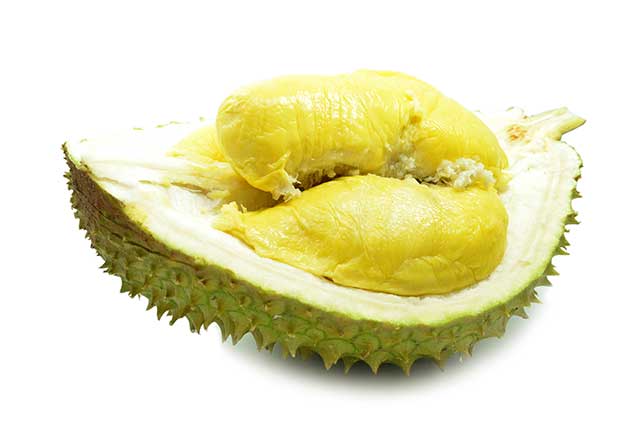
Durian is another unique tropical fruit, and it provides a mixture of fat, carbohydrate, and even a bit of protein.
Other tropical fruits that contain good amounts of fiber include papaya and jackfruit.
Generally speaking, most people who try durian love the taste but hate the smell.
The taste is sweet and creamy, but people often describe the smell as being “like sweaty gym shoes.”
A half-cup serving of durian provides 4.6 grams of fiber (8).
| Fiber: | 9.2 g |
| Total Carbohydrate: | 65.8 g |
| Calories: | 357 kcal |
| Fiber: | 3.8 g |
| Total Carbohydrate: | 27.1 g |
| Calories: | 147 kcal |
8) Elderberries
Elderberries are a small and purple berry with a bitter taste.
The taste is so bitter and tart that most people wouldn’t want to eat them alone, and the raw berries also contain compounds that can lead to toxicity symptoms, meaning they need to be processed before consumption. People usually make them into jellies, jams or teas.
The berries are high in vitamin C and flavonoid polyphenols, and they are one of the most fiber-dense fruits.
A half-cup serving of elderberries offers more than 5 grams of fiber (9).
| Fiber: | 10.2 g |
| Total Carbohydrate: | 26.7 g |
| Calories: | 106 kcal |
| Fiber: | 7 g |
| Total Carbohydrate: | 18.4 g |
| Calories: | 73 kcal |
Find out more about elderberries: Elderberries: 5 Potential Benefits and Full Nutrition Facts
9) Goji Berries (Dried)
Fresh goji berries only grow in certain regions, so they can be tough to find.
However, after exploding in popularity over the past decade, dried goji berries are now a favorite fruit around the world.
Although these berries are quite high in fruit sugar, they offer a good range of nutrients, namely vitamin A, copper, selenium, and vitamin C.
Goji berries are also one of the highest berry sources of fiber, and a one-ounce (28-gram) serving provides 3.6 grams (10).
See here for more information on the nutrition properties of goji berries.
| Fiber: | 3.6 g |
| Total Carbohydrate: | 21.6 g |
| Calories: | 98 kcal |
| Fiber: | 13 g |
| Total Carbohydrate: | 77.1 g |
| Calories: | 349 kcal |
10) Gooseberries
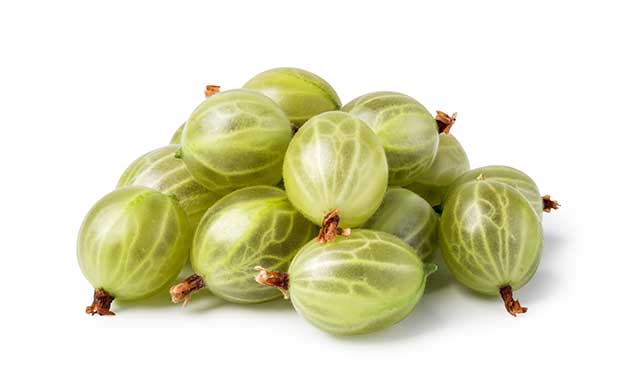
Gooseberries are a tart and slightly sweet berry that taste somewhat like sour grapes.
Although the berries usually have a green color (as shown), they are also available in yellow, white, and reddish shades.
Nutritionally, like many other fruits, gooseberries mainly offer a source of vitamin C.
Gooseberries are also fiber-rich, with 3.25 grams of fiber in a half-cup serving (11).
| Fiber: | 6.5 g |
| Total Carbohydrate: | 15.3 g |
| Calories: | 66 kcal |
| Fiber: | 4.3 g |
| Total Carbohydrate: | 10.2 g |
| Calories: | 44 kcal |
11) Grapefruit (Pink)
Grapefruit is a relatively low-carb fruit that is rich in vitamin C, and a half-cup serving supplies 1.9 grams of fiber (12).
The taste of grapefruit can vary depending on the season and ripeness of the fruit, and it can range from moderately sweet to extremely bitter.
| Fiber: | 3.7 g |
| Total Carbohydrate: | 24.5 g |
| Calories: | 97 kcal |
| Fiber: | 1.6 g |
| Total Carbohydrate: | 10.7 g |
| Calories: | 42 kcal |
12) Guava
The guava is a small tropical fruit with green skin and an inner juicy pink flesh.
The fruit has high moisture content and a sweet taste, and it is an excellent source of vitamin C.
Guava is very rich in fiber too, with just one small fruit providing 3 grams (13).
| Fiber: | 3 g |
| Total Carbohydrate: | 7.9 g |
| Calories: | 37 kcal |
| Fiber: | 5.4 g |
| Total Carbohydrate: | 14.3 g |
| Calories: | 68 kcal |
13) Kumquat
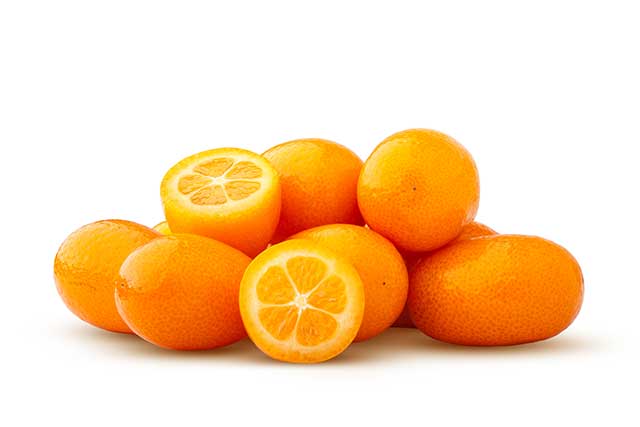
The kumquat is an interesting citrus fruit.
While it may look like a mini orange, it is entirely different.
For one thing, the skin is edible, and people eat the whole fruit without peeling it.
Secondly, the skin has a sweet taste, but the flesh inside is very sour.
Since the skin is also high in fibrous carbohydrates, kumquats offer more fiber than any other citrus fruit.
For instance, just one small 19-gram kumquat fruit offers 1.2 grams of fiber (14).
See this guide for more information on kumquat.
| Fiber: | 1.2 g |
| Total Carbohydrate: | 3 g |
| Calories: | 13 kcal |
| Fiber: | 6.5 g |
| Total Carbohydrate: | 15.9 g |
| Calories: | 71 kcal |
14) Lemon
Owing to the high amounts of citric acid they contain, lemons are one of the more sour fruits.
However, they have a pleasant flavor and provide numerous benefits such as vitamin C and very low sugar content.
Lemons also work well for flavoring drinks such as water and tea.
Due to their low carbohydrate and calorie content, lemons are one of the most fiber-dense fruits available, and they provide 5.1 grams per fruit (15).
| Fiber: | 5.1 g |
| Total Carbohydrate: | 11.6 g |
| Calories: | 21.6 kcal |
| Fiber: | 4.7 g |
| Total Carbohydrate: | 10.7 g |
| Calories: | 20 kcal |
15) Lime
Limes have a lot in common with lemons, and they are from the same family.
However, limes are slightly smaller, and they have more of a bitter taste than the sour-lemon flavor.
Similar to lemons, the lime is also rich in vitamin C, but it doesn’t offer the same concentration of fiber.
Per regular-sized lime, there are 1.9 grams of fiber (16).
| Fiber: | 1.9 g |
| Total Carbohydrate: | 7.1 g |
| Calories: | 20 kcal |
| Fiber: | 2.8 g |
| Total Carbohydrate: | 10.5 g |
| Calories: | 30 kcal |
16) Loganberries
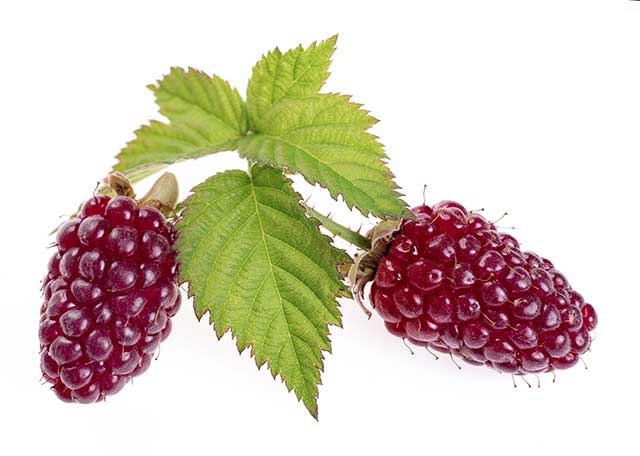
Loganberries are a dark red berry that is a hybrid between the blackberry and raspberry.
Regarding its appearance, the loganberry is long like a blackberry but it has the color of a raspberry, and the taste is somewhere between the two.
Like the closely-related blackberry, loganberries are full of fiber and contain 7.8 3.9 grams per half-cup serving (17).
| Fiber: | 7.8 g |
| Total Carbohydrate: | 19.1 g |
| Calories: | 81 kcal |
| Fiber: | 5.3 g |
| Total Carbohydrate: | 13 g |
| Calories: | 55 kcal |
17) Olives
Aside from the avocado, olives are one of the only fruits that are primarily a source of fat.
Rather than the sweet-tasting fruit sugars, olives provide a wealth of monounsaturated fatty acids.
However, they do contain some carbohydrate, most of which is fibrous carbs.
One ounce (28 grams) of olives provides 0.9 grams of fiber out of 1.1 grams of total carbohydrate (18).
See this overview of different olives for an in-depth guide to olive varieties.
| Fiber: | 0.9 g |
| Total Carbohydrate: | 1.1 g |
| Calories: | 40.6 kcal |
| Fiber: | 3.3 g |
| Total Carbohydrate: | 3.8 g |
| Calories: | 145 kcal |
18) Orange
Oranges are one of the most popular fruits around the world, and this round citrus fruit has a sweet and juicy taste.
Although they don’t contain as much fiber as their miniature-sized relative the kumquat, a large orange still offers 4.4 grams (19).
| Fiber: | 4.4 g |
| Total Carbohydrate: | 21.6 g |
| Calories: | 86.5 kcal |
| Fiber: | 2.4 g |
| Total Carbohydrate: | 11.7 g |
| Calories: | 47 kcal |
19) Passion Fruit
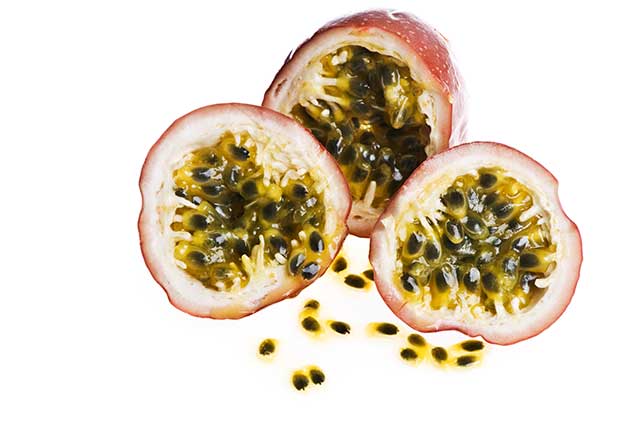
Passion fruit is a small hard-shelled fruit that grows in tropical and sub-tropical regions.
As shown in the picture above, the inside of the fruit has a soft and slimy-looking yellow flesh that contains dozens of seeds.
The taste of the fruit is intensely tart and moderately sweet with a strong flavor.
Passion fruit is a substantial source of fiber, and a small 18-gram fruit provides 1.9 grams (20).
| Fiber: | 1.9 g |
| Total Carbohydrate: | 4.2 g |
| Calories: | 17 kcal |
| Fiber: | 10.4 g |
| Total Carbohydrate: | 23.4 g |
| Calories: | 97 kcal |
20) Pear
Pears are a sweet and juicy fruit that offers a moderate amount of fiber and vitamin C.
Per medium pear, there are 5.5 grams of fiber (21).
Pears grow all around the world, and there are a wide variety of different species and colors of the fruit.
| Fiber: | 5.5 g |
| Total Carbohydrate: | 27.1 g |
| Calories: | 101 kcal |
| Fiber: | 3.1 g |
| Total Carbohydrate: | 15.2 g |
| Calories: | 57 kcal |
21) Persimmon
Persimmons are a large, round orange fruit with a sweet taste.
Appearance-wise, the persimmon looks somewhat like a wide tomato aside from the color difference.
Persimmons are popular throughout the world, but they are native to China, Japan, Korea, and other East-Asian regions.
An average persimmon fruit offers six grams of fiber (22).
| Fiber: | 6 g |
| Total Carbohydrate: | 31.2 g |
| Calories: | 118 kcal |
| Fiber: | 3.6 g |
| Total Carbohydrate: | 18.6 g |
| Calories: | 70 kcal |
22) Plum
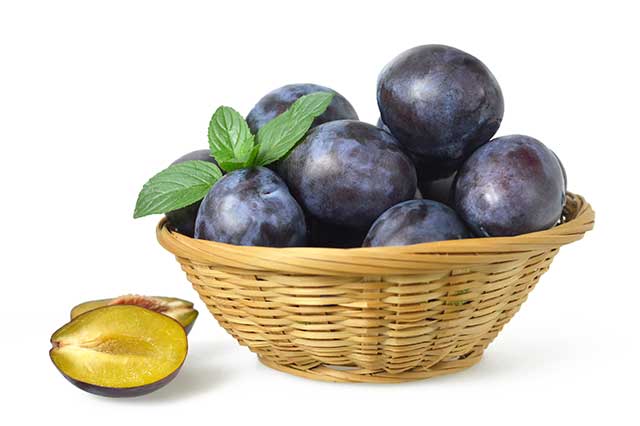
Plums are a small deep-red to purple fruit with sweet and juicy flesh.
The fruit also varies in taste, and at times it tastes sweet but has a tart flavor at other times.
A typical plum weighs around 66 grams and offers 0.9 grams of fiber (23).
| Fiber: | 0.9 g |
| Total Carbohydrate: | 7.5 g |
| Calories: | 30 kcal |
| Per 100 g | |
| Fiber: | 1.4 g |
| Total Carbohydrate: | 11.4 g |
| Calories: | 46 kcal |
23) Pomegranate
The pomegranate is one of the most unusual looking fruits, and it comprises of hard outer skin with lots of edible red seeds inside.
Pomegranate contains moderate amounts of vitamin C, and it is also rich in fiber with a half-cup serving offering 3.5 grams (24).
| Fiber: | 11.3 g |
| Total Carbohydrate: | 52.7 g |
| Calories: | 234 kcal |
| Fiber: | 4 g |
| Total Carbohydrate: | 18.7 g |
| Calories: | 83 kcal |
24) Raspberries
Raspberries are one of the best-tasting berries in the world, and they are particularly delicious alongside some cream.
This soft and sweet berry is also reasonably nutritious, and it contains a good supply of vitamin C and even more fiber than it does fruit sugar.
Per half-cup serving, raspberries offer 8 grams of fiber (25).
For a full guide to the health benefits of raspberries, see this article.
| Fiber: | 8 g |
| Total Carbohydrate: | 14.7 g |
| Calories: | 64 kcal |
| Fiber: | 6.5 g |
| Total Carbohydrate: | 11.9 g |
| Calories: | 52 kcal |
25) Strawberries
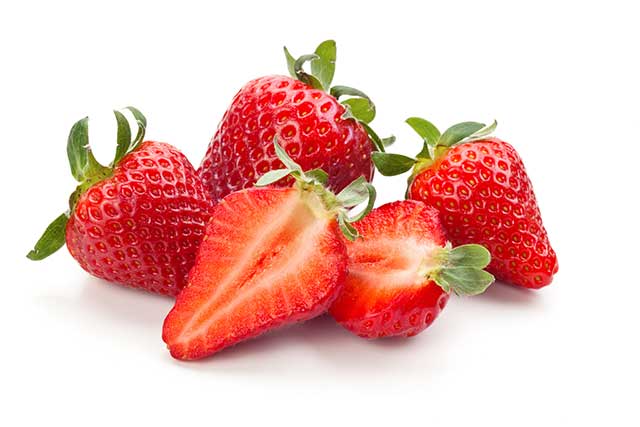
Strawberries are one of the most popular fruits in the world.
With a sweet, juicy taste and an aromatic smell, these berries are a favorite fruit for many people.
Strawberries are an impressive source of vitamin C too, and 100 grams provides more than the RDI for the vitamin.
These tasty red berries are also fiber-rich, and a half-cup serving offers 1.5 grams (26).
For an in-depth look at strawberries, see this guide.
| Fiber: | 3 g |
| Total Carbohydrate: | 11.7 g |
| Calories: | 49 kcal |
| Fiber: | 2 g |
| Total Carbohydrate: | 7.7 g |
| Calories: | 32 kcal |
Ranking Table
To show an at-a-glance guide overview of how all the fruits above compare, the table below sorts the fruit by the highest fiber content per 100 grams.
| Rank # | Fruit Name | Fiber Per 100 g |
| 1 | Goji Berries | 13 g |
| 2 | Passion Fruit | 10.4 g |
| 3 | Elderberries | 7 g |
| 4 | Avocado | 6.8 g |
| 5 | Kumquat | 6.5 g |
| 6 | Raspberries | 6.5 g |
| 7 | Guava | 5.4 g |
| 8 | Blackberries | 5.3 g |
| 9 | Loganberries | 5.3 g |
| 10 | Breadfruit | 4.9 g |
| 11 | Lemon | 4.7 g |
| 12 | Gooseberries | 4.3 g |
| 13 | Pomegranate | 4 g |
| 14 | Durian | 3.8 g |
| 15 | Cranberries | 3.6 g |
| 16 | Persimmon | 3.6 g |
| 17 | Olives | 3.3 g |
| 18 | Pear | 3.1 g |
| 19 | Lime | 2.8 g |
| 20 | Blueberries | 2.4 g |
| 21 | Orange | 2.4 g |
| 22 | Apple | 2.4 g |
| 23 | Strawberries | 2 g |
| 24 | Grapefruit | 1.6 g |
| 25 | Plum | 1.4 g |
Bear in mind that goji berries are dried fruit, which partly explains why they are higher in fiber (and total calories and carbohydrate) than the rest.
Other dried fruits would also be high in fiber, but goji berries are only available in their dried form, hence their inclusion.

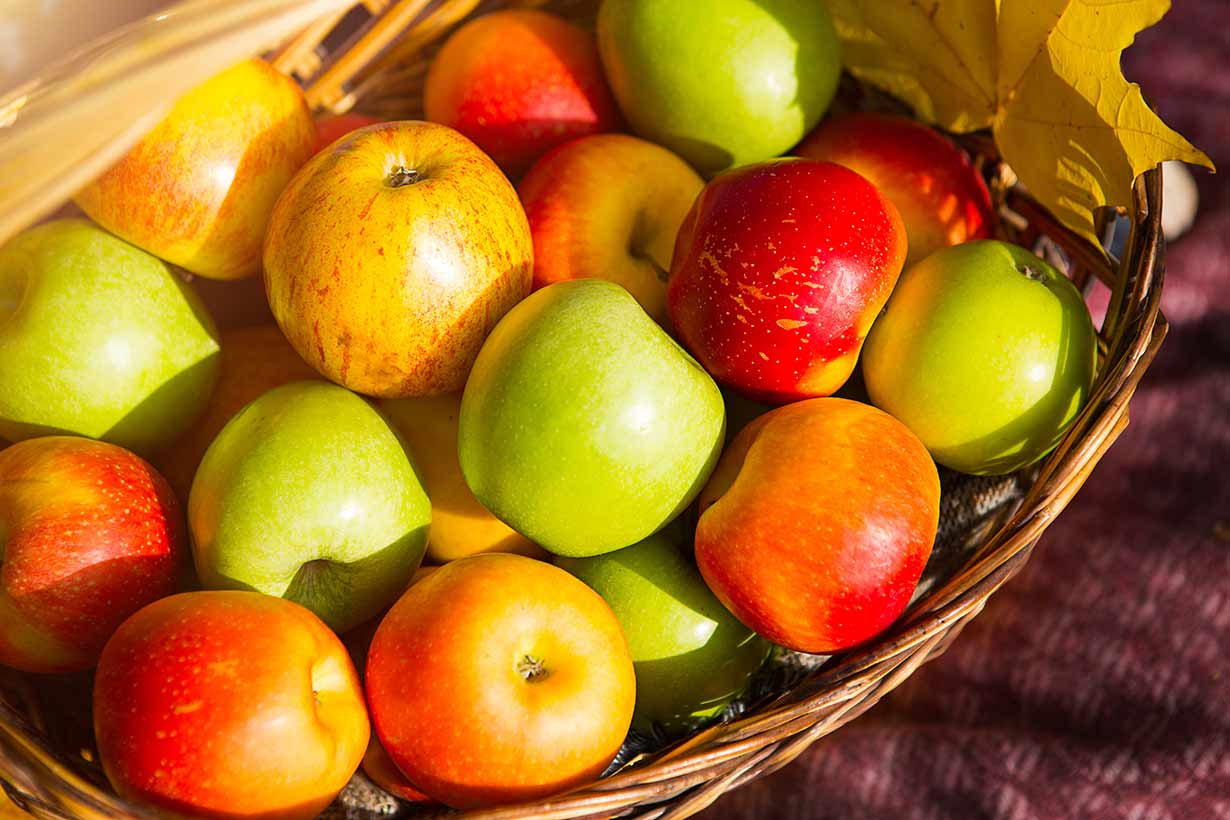


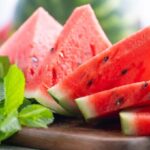

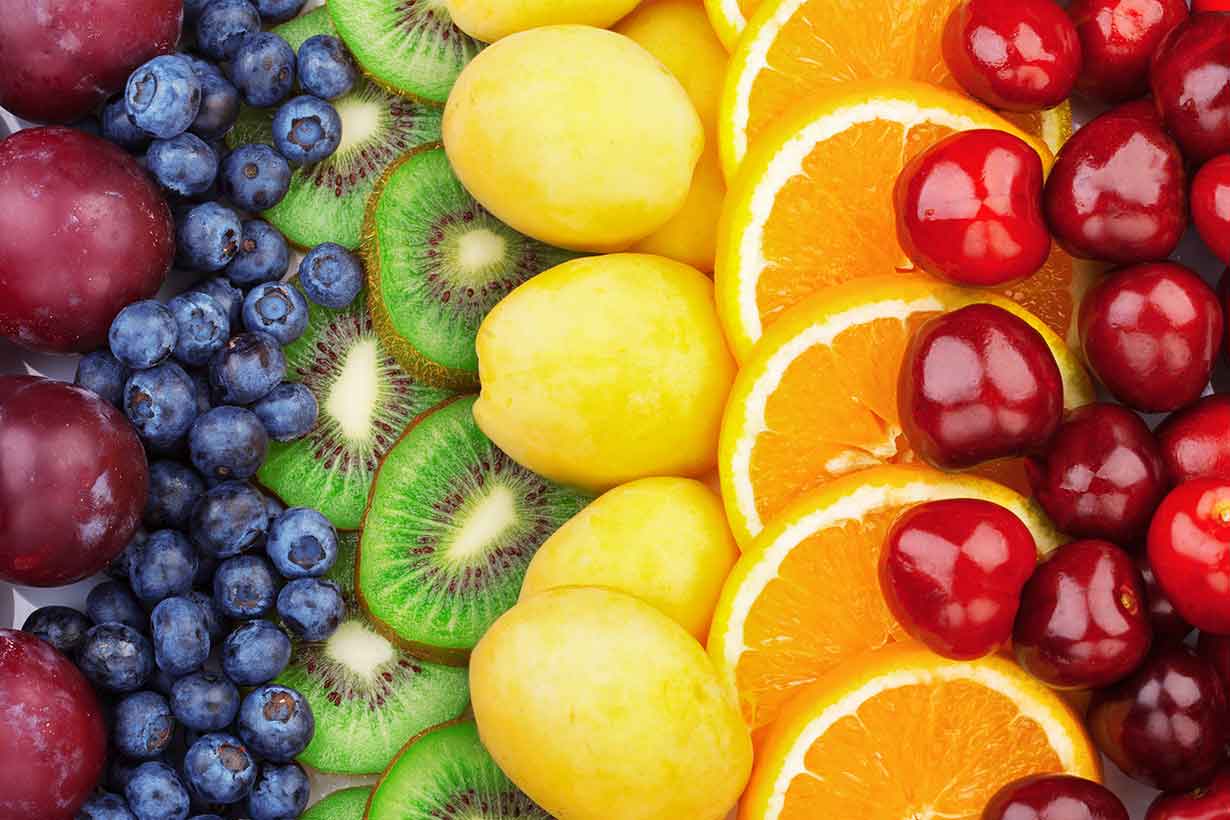
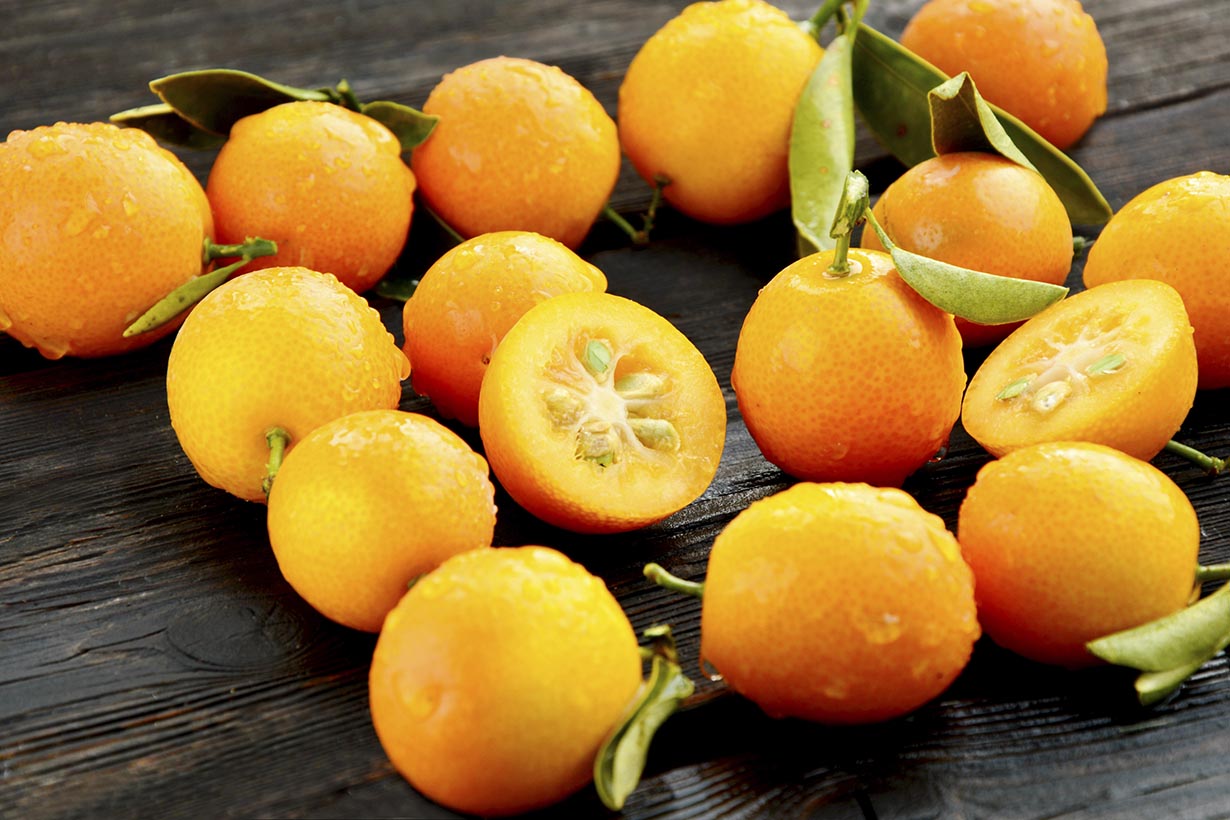

Excellent I have been wanting this to help me with Keto It is hard to keep the carbs down Robyn
Glad it helps, Robyn, and good luck with your diet!